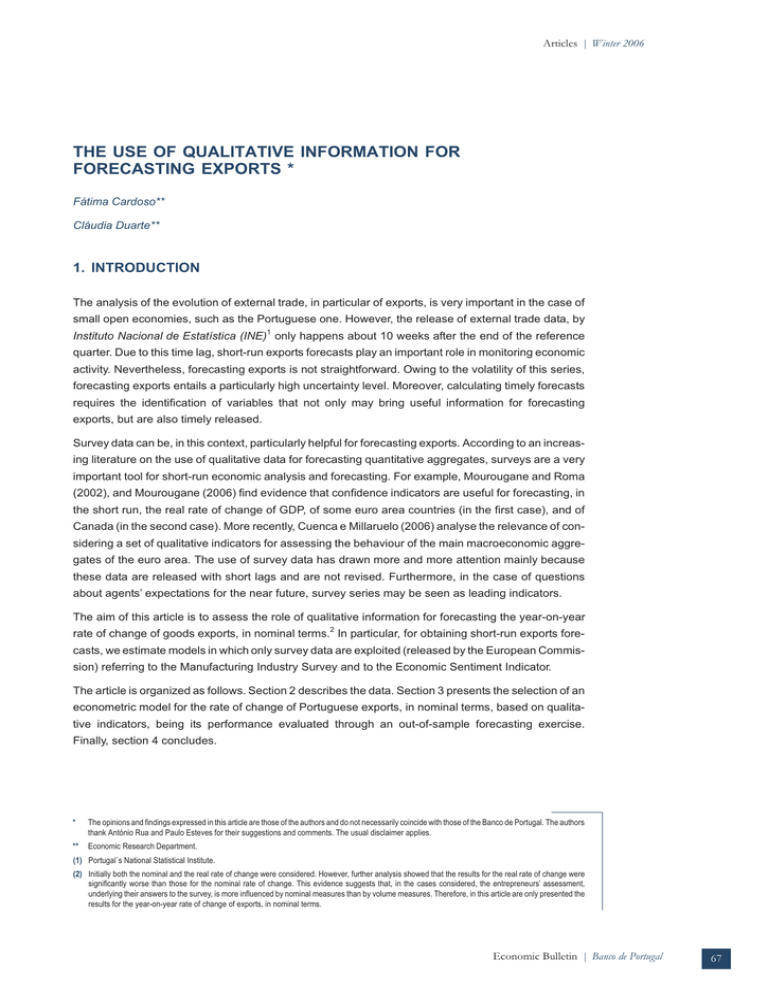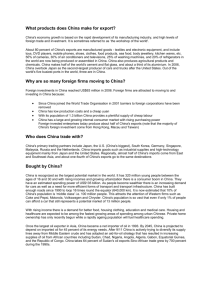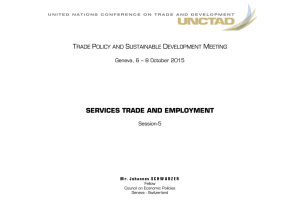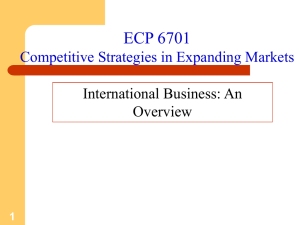THE USE OF QUALITATIVE INFORMATION FOR FORECASTING EXPORTS * 1. INTRODUCTION
advertisement

Articles | Winter 2006
THE USE OF QUALITATIVE INFORMATION FOR
FORECASTING EXPORTS *
Fátima Cardoso**
Cláudia Duarte**
1. INTRODUCTION
The analysis of the evolution of external trade, in particular of exports, is very important in the case of
small open economies, such as the Portuguese one. However, the release of external trade data, by
Instituto Nacional de Estatística (INE)1 only happens about 10 weeks after the end of the reference
quarter. Due to this time lag, short-run exports forecasts play an important role in monitoring economic
activity. Nevertheless, forecasting exports is not straightforward. Owing to the volatility of this series,
forecasting exports entails a particularly high uncertainty level. Moreover, calculating timely forecasts
requires the identification of variables that not only may bring useful information for forecasting
exports, but are also timely released.
Survey data can be, in this context, particularly helpful for forecasting exports. According to an increasing literature on the use of qualitative data for forecasting quantitative aggregates, surveys are a very
important tool for short-run economic analysis and forecasting. For example, Mourougane and Roma
(2002), and Mourougane (2006) find evidence that confidence indicators are useful for forecasting, in
the short run, the real rate of change of GDP, of some euro area countries (in the first case), and of
Canada (in the second case). More recently, Cuenca e Millaruelo (2006) analyse the relevance of considering a set of qualitative indicators for assessing the behaviour of the main macroeconomic aggregates of the euro area. The use of survey data has drawn more and more attention mainly because
these data are released with short lags and are not revised. Furthermore, in the case of questions
about agents’ expectations for the near future, survey series may be seen as leading indicators.
The aim of this article is to assess the role of qualitative information for forecasting the year-on-year
rate of change of goods exports, in nominal terms.2 In particular, for obtaining short-run exports forecasts, we estimate models in which only survey data are exploited (released by the European Commission) referring to the Manufacturing Industry Survey and to the Economic Sentiment Indicator.
The article is organized as follows. Section 2 describes the data. Section 3 presents the selection of an
econometric model for the rate of change of Portuguese exports, in nominal terms, based on qualitative indicators, being its performance evaluated through an out-of-sample forecasting exercise.
Finally, section 4 concludes.
*
The opinions and findings expressed in this article are those of the authors and do not necessarily coincide with those of the Banco de Portugal. The authors
thank António Rua and Paulo Esteves for their suggestions and comments. The usual disclaimer applies.
**
Economic Research Department.
(1) Portugal´s National Statistical Institute.
(2) Initially both the nominal and the real rate of change were considered. However, further analysis showed that the results for the real rate of change were
significantly worse than those for the nominal rate of change. This evidence suggests that, in the cases considered, the entrepreneurs’ assessment,
underlying their answers to the survey, is more influenced by nominal measures than by volume measures. Therefore, in this article are only presented the
results for the year-on-year rate of change of exports, in nominal terms.
Economic Bulletin | Banco de Portugal
67
Winter 2006 | Articles
2. DATA
The database used consists of quarterly series covering the period from the first quarter of 1996 to the
second quarter of 2006. The purpose of the analysis is to forecast the year-on-year rate of change of
goods exports, in nominal terms, released by INE. As it can be seen in Chart 1, this variable denotes
some volatility.
For forecasting the developments in exports qualitative series are used, both monthly and quarterly,
referring to the Manufacturing Industry Survey, released by the European Commission. This enquiry,
within the scope of the harmonised European enquiries, aims at collecting information about entrepreneurs’ opinion regarding the evolution of their companies’ activity. The survey, monthly delivered to a
sample of about 1117 companies, consists of 18 questions (8 monthly and 10 quarterly). These questions can refer to ex-ante (next three months) or to ex-post periods (reference month or last three
months). Considering the definition of the answer collecting period, the evaluation of the reference
month is based on the first 20 days of that month.
From the set of 18 questions, it was made an initial selection, being only chosen the questions that are
directly related to exports. In particular, the analysis encompasses four questions from the quarterly
survey and another four questions from the monthly survey.
In the case of the quarterly survey, the questions chosen refer to new orders recently received (nenct),
to export expectations for the next months (eexpt) and to the competitive position in the intra- and extra-community markets (pcit e pcet). Combining these last two variables, and using as weights the ratio
of intra- and extra-community trade to the total external trade, a new variable was built (compt) which
can be interpreted as a global indicator of Portuguese exports competitiveness.
Regarding the monthly survey, the questions analysed refer to the recent production trend (prodt), to
total and export order books (cenct e cexpt) and to production expectations for the next months
(eprodt).
The qualitative series are presented as balances, defined as the difference between positive and
negative answers, and are seasonally adjusted. In addition to the aggregated totals, the variables from
Chart 1
YEAR-ON-YEAR RATE OF CHANGE OF EXPORTS,
IN NOMINAL TERMS
20
15
Per cent
10
5
0
-5
-10
1996 Q1
1998 Q1
2000 Q1
Source: INE (International Trade Statistics).
68
Banco de Portugal | Economic Bulletin
2002 Q1
2004Q1
2006 Q1
Articles | Winter 2006
the Manufacturing Industry Survey are also available disaggregated by economic activities (NACE).3
The aggregation of the series for each question reflects the weights of each branch (measured by the
turnover) in the total. Since, in this case, the aim is modelling and forecasting the year-on-year rate of
change of exports, instead of only using the original overall series, it was also considered a set of series resulting from aggregating the disaggregates by economic activity, using as weights the ratios of
the exports of each branch to the total exports (henceforth denoted by the suffix p).
Furthermore, adding to the variables from the Manufacturing Industry Survey, it was built a new variable, based on the Economic Sentiment Indicators of the several countries of the European Union
(EU) (piset). This variable, which can be seen as a proxy of the external demand of Portuguese exports, is a weighted average of the Economic Sentiment Indicators of the several Members of the EU,
whose weights reflect the structure of Portuguese exports disaggregated by destination country.
In the context of a quarterly database, monthly series have to be transformed into quarterly series. In
this case, the quarterly figures were obtained by averaging the monthly ones, considering more than
one way of distributing the months among the quarters. Traditionally, the first quarter refers to the
months of January, February and March, and so on so forth. Moreover, we also considered lags of one
month (henceforth denoted by the suffix d1), corresponding the first quarter to December, January and
February, and of two months (henceforth denoted by the suffix d2), with the first quarter equal to the
average of November, December and January. This procedure allows testing the existence of several
kinds of lags (in months) in the relation between the qualitative variables and exports.
3. MODELLING
3.1. First approach: cross correlations analysis
Considering the size of the database, in a first approach, bivariate correlations between the variation of
exports and potential explanatory variables were analysed. From the results attained, it is possible to
conclude that the correlations calculated from the weighted series, whose weights reflect the
disaggregation by NACE of Portuguese exports, are, in general, higher than the correlations from the
original data. Taking into account this evidence (subsequently confirmed by robustness checks during
model estimation) it was chosen to work with the weighted series, whose weights are based on the
Portuguese exports structure.
Analysing the correlations calculated from these series, it is possible to identify three different situations: in the case of export expectations for the next months (eexppt) the highest correlation is registered in a lagged period (t-2); for the variables referring to new orders recently received (nencpt), to
export order books, contemporaneous and lagged one month (cexppt e cexpd1pt) and to the proxy of
external demand (piset) the highest correlation values are registered in the contemporaneous period;
in all the other cases the highest value is most commonly registered in the period t+1 (see Table 1).
This evidence suggests that the variables nencpt, eexppt, cexppt, cexpd1pt e piset may be seen as coincident indicators (and lead indicator, in the case of eexppt) of the rate of change of exports. Nevertheless, even in the cases where the highest correlation is registered in periods after t, the value of the
correlations in t and in lagged periods is still reasonably high.
In addition, the analysis of the table suggests that using the series from the monthly survey lagged one
and two months does not seem to significantly improve correlations. In fact, the use of lags of less than
(3) NACE – Statistical classification of economic activities in the European Community. Note that, at least at the disaggregation level considered in this article
(two-digit), there is a direct correspondence between this classification and the current Portuguese classification of economic activities (CAE).
Economic Bulletin | Banco de Portugal
69
70
Banco de Portugal | Economic Bulletin
-0.171
-0.226
-0.274
-0.064
-0.102
-0.271
0.114
-0.042
-0.071
-0.249
0.139
0.032
-0.033
-0.216
0.204
-0.042
0.258
-0.122
0.161
-0.068
t-4
0.046
-0.030
-0.107
0.105
0.032
-0.110
0.254
0.206
0.103
0.017
0.311
0.239
0.168
0.132
0.301
0.178
0.400
-0.041
0.195
0.009
t-3
0.325
0.226
0.134
0.274
0.225
0.234
0.330
0.327
0.297
0.349
0.394
0.429
0.368
0.447
0.475
0.428
0.552
0.000
0.201
0.049
t-2
0.600
0.519
0.431
0.484
0.445
0.555
0.467
0.508
0.515
0.632
0.464
0.517
0.563
0.683
0.463
0.624
0.513
0.410
0.238
0.400
t-1
0.737
0.707
0.661
0.548
0.580
0.716
0.437
0.556
0.594
0.756
0.489
0.591
0.601
0.773
0.522
0.678
0.540
0.526
0.497
0.541
t
0.704
0.739
0.754
0.612
0.618
0.750
0.539
0.598
0.631
0.728
0.544
0.593
0.616
0.666
0.563
0.631
0.431
0.679
0.577
0.686
t+1
0.479
0.559
0.639
0.539
0.592
0.617
0.565
0.512
0.541
0.540
0.593
0.469
0.505
0.446
0.529
0.533
0.246
0.695
0.555
0.692
t+2
0.279
0.351
0.411
0.477
0.460
0.312
0.533
0.429
0.403
0.216
0.489
0.448
0.363
0.107
0.516
0.293
0.143
0.390
0.317
0.389
t+3
0.062
0.123
0.200
0.388
0.331
0.040
0.511
0.333
0.298
-0.005
0.417
0.227
0.262
-0.085
0.314
0.123
-0.094
0.126
0.134
0.131
t+4
Note: All correlations are calculated for the weighted series, whose weights reflect the Portuguese exports structure. The values refer to the correlation between the rate of change of exports in the period t and the qualitative indicators in period t + i (i Î {-4 , . . . , 4}) . The shaded area denotes the highest correlation coefficient.
Proxy of the external demand (piset)
Lagged one month (pised1t)
Lagged two months (pised2t)
Economic Sentiment Indicators
Recent production trend (prodt)
Total order books (cenct)
Export order books (cexpt)
Production expectations for the next months (eprodt)
Lagged two months
Recent production trend (prodt)
Total order books (cenct)
Export order books (cexpt)
Production expectations for the next months (eprodt)
Lagged one month
Recent production trend (prodt)
Total order books (cenct)
Export order books (cexpt)
Production expectations for the next months (eprodt)
Monthly survey
New orders recently received (nencpt)
Export expectations for the next months (eexppt)
Competitive position in the intra-community market (pcit)
Competitive position in the extra-community market (pcet)
Global indicator of competitiveness (compt)
Quarterly survey
Manufacturing Industry Survey
CORRELATION COEFFICIENTS
Table 1
Winter 2006 | Articles
Articles | Winter 2006
a quarter (one and two months) does not, in general, increase the correlation with the variation of exports, for lagged and contemporaneous periods.
3.2. Model estimation
The aim of this section is to choose the model specification, namely the variables to include, which
allows attaining the best results in terms of forecasting the variation of exports. This choice takes into
account the principle of parsimony, but, even so, we try to cover an information set as wide as possible.
To represent the rate of change of exports, Autoregressive Distributed Lags (ADL) models are
considered, with the following form:
k
q (L) y t = å di (L) x i , t + et
k = 1,..., n
i =1
in which y t is the year-on-year rate of change of Portuguese exports, in nominal terms, x i , t are the
qualitative indicators, q (L) and di (L) are lag polynomials and et is the residual variable (e = 0 and
standard deviation = s2 ). For model identification purposes it was used a sample from 1997Q1 to
2004Q2.
Due to the interest in obtaining timely forecasts, during model specification the qualitative variables
were only introduced contemporaneously and with lags (n = 4). Furthermore, adding to economic interpretation, model selection was based on the Schwarz criterion. Based on this criterion, the model chosen,4 as follows,5
y$ t = -25.34 -0.44y t -4 +0.19eexpp t - 2 +0.22cexpp t +0.34pise t
[-1. 64] [-5. 00]
[1. 92]
[2. 24]
[2.44]
(1)
Adjusted R2 = 0.79
Dependent variable standard deviation = 6.33
Residuals standard deviation = 2.88
has as regressors: the dependent variable (rate of change of exports) lagged four periods ( y t -4 ), which
enables the model to capture base effects; from the quarterly survey, export expectations for the next
months, lagged two periods (eexppt-2); from the monthly survey, export order books (cexppt); and,
lastly, the proxy of external demand of Portuguese exports (piset). There is no evidence of
autocorrelation until the order 4 in this model.
Considering the sample that was not used in model identification (2004Q3 to 2006Q2) it was simulated
an out-of-sample forecasting exercise. The results of this exercise were evaluated according to the
root mean squared forecast error (RMSFE), which, in this case, is 2.60 (see Chart 2).
(4) It is worth noting that other models, with similar results, were obtained. However, the model chosen presented the best fit in-sample and the best forecasting
performance.
(5) The t-ratios are presented in square brackets.
Economic Bulletin | Banco de Portugal
71
Winter 2006 | Articles
Chart 2
YEAR-ON-YEAR RATE OF CHANGE OF EXPORTS,
IN NOMINAL TERMS
20
Observed values
Fitted values
Forecasts
15
Per cent
10
5
0
-5
-10
1996Q1 1997Q3 1999Q1 2000Q3 2002Q1 2003Q3 2005Q1
Note: The shaded area corresponds to a 95% confidence interval.
Comparing the model chosen with a univariate benchmark,6 one concludes that the model with qualitative variables has a better performance, both in-sample and out-of-sample, than the univariate model,
which presents a residuals standard deviation equal to 4.59 and a RMSFE of 3.21.
In order to assess the robustness of the model to the sample used it was carried out a sensitivity analysis. According to the results of this analysis, the model appears to be robust to changes in the sample
dimension. In particular, when estimating the selected model using the full sample (1997Q1 to
2006Q2) the coefficients remain stable and statistically significant.
Sample: 1997Q1 – 2006Q2
y$ t = -23.55 -0.44y t -4 +0.17eexpp t - 2 +0.24cexpp t +0.33pise t
[-1. 66] [-5. 20]
[2.41]
[2.44]
[2. 51]
(2)
Adjusted R2 = 0.77
Residuals standard deviation = 2.81
3.3. More timely estimates: indicators with incomplete quarterly information
The selected model, described in the previous section, presents the best forecasting performance,
and gives one estimate to the rate of change of exports about 70 days before the release of the official
data.
(6) The univariate benchmark has the following specification:
y$ t = 4 .50 +0.62y t - 1 -0.32y t - 4
[3.07] [4 .59]
[-2.39]
with t-ratios presented in square brackets.
6
66666
72
Banco de Portugal | Economic Bulletin
Articles | Winter 2006
In an attempt to obtain an estimate even earlier, alternative models were estimated in which, starting
from the previously selected model (see (1)), the contemporaneous regressors are replaced with
equivalent series that result from only considering information about a fraction of the quarter. Obviously, this is possible because, in the model chosen, the contemporaneous variables are from the
monthly survey. Therefore, for both these variables (export order books (cexppt) and proxy of external
demand (piset)), alternative series were calculated, where the quarterly observations are replaced by
the data referring to the first month (henceforth denoted by the suffix m1) or to the average of the first
two months of the respective quarter (henceforth denoted by the suffix m2).
Consequently, it is possible to obtain a first estimate of the quarterly variation of exports from a model
with a specification similar to (1) but in which the variables referring to the export book orders (cexppt)
and to the proxy of external demand of the Portuguese exports (piset) are replaced by the corresponding variables with information on the first month of each quarter only (cexpm1pt e pisem1t).
y$ t = -26.86 -0.44y t -4 +0.18eexpp t - 2 +0.23cexpm 1p t +0.36pisem 1t
[-2.15] [-5. 00]
[2.18]
[2. 39]
[3.12]
(3)
In the same way, it can be obtained a second estimate using the variables with information on first two
months of each quarter (cexpm2pt e pisem2t).
y$ t = -23.74 -0.44y t -4 +0.18eexpp t - 2 +0.25cexpm 2p t +0.33pisem 2t
[-1. 64] [-5.11]
[2. 21]
[2. 26]
[2. 51]
(4)
Considering as a third estimate the one obtained from the model initially chosen, that is, from the
model in which all indicators refer to complete quarters, Table 2 summarises the estimation and forecasting results over the three stages:
As expected, the results obtained, both for the RMSFE and for the accuracy on predicting direction
changes, worsen as less information concerning each quarter is used. Nevertheless, by incurring this
slight loss of quality it is possible to obtain more timely estimates. Furthermore, even considering the
model with information only for the first month of the quarter, its results are still better than the ones of
the univariate model.
The results obtained suggest that it is possible to have more timely forecasts for the variation of exports, without its quality being significantly affected, by using incomplete quarterly information. Moreover, including these variables in the model allows taking into account the monthly data as soon as
they are released, without having to wait for gathering information for the whole quarter.
Table 2
MODEL COMPARISON
Models
RMSFE
Matching of the variation
Forecast timeliness(b)
sign(a) (%)
(days)
One month information
2.96
70.3
130
Two months information
2.85
73.0
100
Complete quarter information
2.60
73.0
70
Notes: (a) The matching of the variation sign measures the number of times that the sign of the variation of the series of interest (which is the rate of change of exports) is equal to the one
of the variation of the fitted values and forecasts of the model (in percentage).(b) Forecast timeliness refers to the period of time elapsed between the calculation of the forecast and the
release of exports data.
Economic Bulletin | Banco de Portugal
73
Winter 2006 | Articles
4. FINAL REMARKS
In this article it is assessed the importance of using qualitative data, from opinion surveys, for forecasting exports in the short run. In particular, a model for the quarterly year-on-year rate of change of exports is estimated, considering qualitative series from the Manufacturing Industry Survey, referring to
Portugal, and the Economic Sentiment Indicators, referring to the EU countries, both released by the
European Commission.
Based on the model selected, some alternative models are also estimated in an attempt to obtain estimates as early as possible, vis-à-vis the release of the data. The models presented produce estimates
for the evolution of exports between 70 and 130 days before the release of the exports figures.
For the purpose of obtaining timely forecasts for the variation of exports, one concludes that the qualitative information is particularly relevant for this matter and that it provides a leading indication on exports’ behaviour. Furthermore, the results obtained point to the stability of the model in relation to the
sample used. It should be noted, however, that forecasting exports entails some difficulties due to the
volatility of the series.
The favourable results that were achieved, in this case, can be seen as an incentive to further research
on the use of this methodology for forecasting other quantitative aggregates.
BIBLIOGRAPHY
Artís, M. et al. (2003), Forecasting models currently applied to indicators computed on the basis of
surveys results, European Commission.
European Central Bank (2001), “The information content of composite indicators of the euro area
business cycle”, Monthly Bulletin, November.
Britton, E. e Cutler, J. (1999), “The Bank’s use of survey data”, Quarterly Bulletin, May, Bank of
England.
European Commission (2006), Using factor models to construct composite indicators from BCS data –
a comparison with European Commission confidence indicators
Cuenca, J. e Millaruelo, A. (2006), “Las encuestas de opinión y el análisis de coyuntura de la actividad
real de la UEM”, Boletin Económico, January, Banco de España.
Hansson, J. et al. (2003), “Business Survey Data: Do They Help in Forecasting the Macro Economy?”,
The National Institute of Economic Research, Working Paper nº 84.
Mourogane, A. e Roma, M. (2002), “Can confidence indicators be useful to predict short term real GDP
growth?”, Working paper nº 133, European Central Bank.
Mourougane, A. (2006), “Forecasting monthly GDP for Canada”, Economics Department Working
paper nº515, OCDE.
Rua, A. (2002), “Composite indicators for the Euro Area economic activity”, Economic Bulletin,
September, Banco de Portugal.
Santero, T. e Westerlund, N. (1996), “Confidence indicators and their relationship to changes in
economic activity”, Economics Department Working paper nº170, OCDE.
Santos, R. (2003), “The use of qualitative data for short term analysis”, Economic Bulletin, September,
Banco de Portugal.
74
Banco de Portugal | Economic Bulletin





